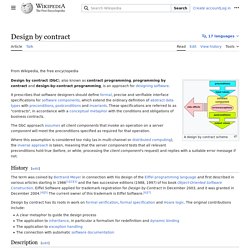

Programming by Contract. A paradigm which was first introduced by Bertrand Meyer, the creator of Eiffel. Although Eiffel has support for programming by contract built into the language, most of the concepts can be used in any language. Programming by contract has reduced my time in the debugger by 90% or more - thus my belief in it. It also greatly reduces the need for error checking within your code since you "know" that a calling routine will have valid values coming into the routine.
It also provides valuable user documentation which can be extracted by automated tools (such as the tool found in Eiffel implementations. Basically programming by contract creates a contract between the software developer and software user - in Meyer's terms the supplier and the consumer. As an example, you might have a routine which expects an incoming paramater to be a non-NULL class pointer and guarantees to return the class with some new data stuffed in it. Design by contract. A design by contract scheme The DbC approach assumes all client components that invoke an operation on a server component will meet the preconditions specified as required for that operation.

Where this assumption is considered too risky (as in multi-channel client-server or distributed computing) the opposite "defensive design" approach is taken, meaning that a server component tests (before or while processing a client's request) that all relevant preconditions hold true, and replies with a suitable error message if not. History[edit] Design by contract has its roots in work on formal verification, formal specification and Hoare logic. The original contributions include: Description[edit] The central idea of DbC is a metaphor on how elements of a software system collaborate with each other on the basis of mutual obligations and benefits.
The contract is semantically equivalent to a Hoare triple which formalises the obligations. What does contract expect? Performance implications[edit] The Critical Role of Agility in Mobile App Deployment. The Critical Role of Agility in Mobile App Deployment by Brian J.

Dooley The intersection between agile and mobile development is a natural one, grounded in the similarities between the demands of each. Mobile apps are generally small, frequently updated from an apps store, motivated by clear process requirements, and released almost immediately. Individual apps are, in many ways, like SOA applets, providing key, limited functionality in an accessible manner as the user requires. To continue, please log in: This document is available to Cutter Consortium Resource Center clients only. 12-681, Software Development: Effective Practices and Federal Challenges in Applying Agile Methods.
Modular, Agile Guidance. Agencies now have a how-to guide to use agile or modular contracting for IT projects.

The document details eight key principles of modular contracting, highlights possible risks or challenges and offers checklists, templates and other tools to make the move to this smaller, more outcome-based approach easier for agencies. Federal Chief Information Officer Steve VanRoekel and Office of Federal Procurement Policy Administrator Joe Jordan released the guidance Thursday as part of the 18-month anniversary of the 25-point IT reform plan. Shift from 'bloated, multi-year projects' In a blog post, VanRoekel and Jordan said the guidance "encourages agencies to shift away from the bloated, multi-year projects so common in the past to a more nimble approach.
The modular approach requires agencies to complete sections of the program frequently — every three-to-six months. The Office of Management and Budget has talked for several years about moving toward agile development. Touting TechStat. Modular Approaches for Information Technology (IT) Development and Acquisition.